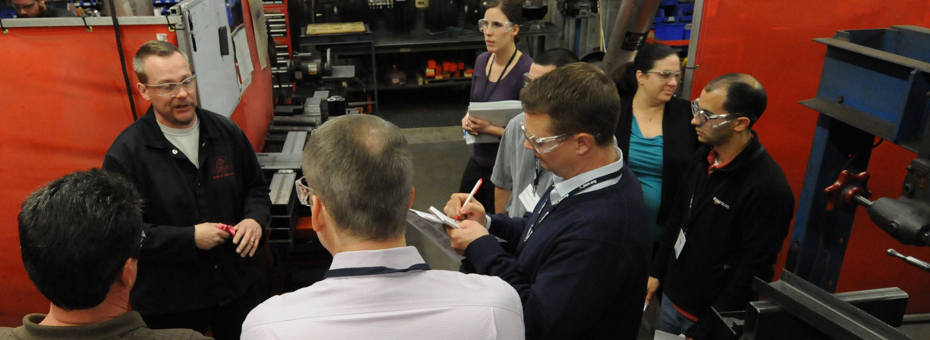A friend of mine who is the General Manager of a division of a large manufacturing company asked me to visit one of his plants. As luck would have it, my visit happened to come one day after the Company President and several of his senior VPs visited the plant. The plant manager assumed I wanted to take a tour similar to that taken by the senior executives.
But I asked him to take me where their most important, biggest selling product was produced. Since it was a build to stock product, I said let’s start in shipping and their warehouse for the finished parts. I talked with the people working in the area and asked about how well they were able to respond to their customer’s demand. How did they decide how much inventory to keep? What methods did they use to adjust to changes in demand? How much variability did they have in demand and what caused it?
We walked upstream to where the parts were produced. I just watched people actually doing the work as supervisors explained the production process. I asked what their major issues were and heard about problems with capacity and changes in production schedules. What I saw was equipment that was idle and work-in-process inventories that seemed out of sync with production schedules. I heard stories of how supervisors constantly had to jump in and solve problems and adjust schedules. And, I saw little evidence of standard work or improvement activities by the people who did the work. It seemed that improvement was done by the lean team and supervisors.
The supervisors talked about the significant improvements they were making as a result of kaizen events. But all I noticed was workers trying to keep up with a production process that looked out of sync, plagued by problems that got in the way of them being able to perform their jobs well.
We walked on to observe the processes where the orders were taken, materials were purchased, and production schedules were established and released to the floor. Again I had questions about the reliability of their processes and how issues were surfaced and resolved.
Finally, we ended up at their white board information center. At the information center I noticed that their value stream maps really did not match up with the processes I had observed on my walk. I also noticed that the improvement project priority list did not match up with what I saw people actually working on. In addition, the issues I saw and heard about on my walk didn’t seem to be reflected at all on the communication board.
I had asked a lot of questions and the plant manager didn’t seem very happy, so I said, “How about a beer?” Over a beer, he said he was frustrated by how hard it was to answer my questions. He said they pointed out how little he actually knew about the details of their issues. He asked why the senior executive visitors the previous day had not seen the same issues or asked the same questions. He said he felt like their visit was just a waste of everyone’s time. Just a big show and tell with little real discussion about the business. I said too often managers take walks in their facilities as if they were tourists. They visit pre-staged points-of-interest and make casual observations about what they see like “you have a lot of inventory” or “the plant looks good.” They ask meaningless questions like “how is it going?” They review information boards to check on compliance to corporate standards rather than real problems and improvements. And finally, they encourage local management to do better on financial results.
These senior executives are going to the gemba to be seen rather than going to see and understand. They may be well intentioned, but they are following a script rather than a thought out plan. They take the walk to make an appearance, show their support and interest, reinforce the need for improvement in financial results or to deliver a pre-determined message. They spend most of their time in the conference room and at the communication boards reviewing performance. The effect is that they take a “tour” rather than a true gemba walk.
Lean thinking would have us always take a walk with a purpose. A senior manager would take a walk to better understand how well the management process is working. How effective is the daily management process? Does it focus on the few key measures and issues of the organization (like Safety, Quality, Delivery, and Cost)? How well is the improvement process and problem solving process working? What is the routine or “Kata” (see Toyota Kata)? How engaged are the people? Is coaching happening at the appropriate level and is it aligned to drive organizational results? Focusing on these things is what will drive sustainable results. If you only focus on financial results and compliance to corporate measures, you miss the point of a gemba walk and do little if anything to help your team.
Remember, the lean motto of Purpose, Process, People:
PURPOSE – Why are you taking the walk? What is it you are trying to deeply understand by going to the gemba?
PROCESS – How will you take the walk? What is the flow you are looking to understand? Where will you start? How long will you take?
PEOPLE – How can you look for alignment of the people to the important objectives? How will you understand if they are overburdened by too many initiatives? How will you check to see if they are working in stable conditions versus chaos? And most importantly, how will you manage the impact of your walk (as it is seldom what you expect)?
Here is a contrast between what I often see as the standard senior management plant visit versus a “lean thinking” visit:
Typical Plant Tour Visit
- Start in fancy office conference room for sit down meeting with coffee where functional location managers make PowerPoint presentations about how well things are going – 60% of visit time
- Go to communications board in plant where all the corporate measures are displayed and review the measures – 10% of visit time
- Go on pre-arranged plant tour designed to reinforce the previous presentations and highlight the best areas of the facility (newest equipment, cleanest areas, nicest labs, latest kaizen) – 20% of visit time
- Go back to fancy conference room for senior visitor feedback typically consisting of a mix of compliments on superficial things like plant cleanliness and feedback reinforcing the need to do better on the corporate measures – 10% of visit time
Lean Thinking Gemba Walk
- Start in a plant conference room for a stand up review of safety protocols within the plant and people introductions – 5% of visit time
- Walk the floor – no pre-arranged tour or route (follow value streams, ask questions to understand how well the business is doing, get answers from people on the floor) – 60-70% of visit time
- Go to communications board to see if it matches up with the observations from walking the floor (ask questions about performance measures, what are your biggest problems, how do you prioritize improvement projects) – 10-15% of visit time
- Go to plant conference room to review strategy deployment and improvement plans (A3s) on key issues and performance gaps. Senior visitor provides feedback on specific action plans and decides a time when they will return for review – 15-20% of visit time
Are you going to see and understand or are you just making an appearance to be seen?




